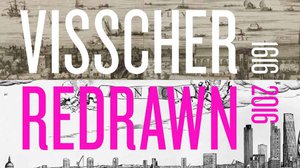Visscher Redrawn 1616-2016
A display of Visscher’s iconic 1616 depiction of medieval London alongside artist Robin Reynolds' version of modern London.
Friday 18 November 2016
Guildhall Art Gallery
Review by Hannah Drennan, MA Shakespeare Studies
Visscher’s masterpiece ‘Panorama of London 1616’ was displayed in Guildhall Art Gallery from the 20th February to 20th November 2016. As I entered the room to look at the exhibition I was struck by the haunting beauty of the Visscher panorama, visually capturing the architecture and life of late Medieval/Early Modern London before the Great Fire of London in 1666 in which much of the City was destroyed. Displayed beside Visscher’s piece was artist and illustrator Robin Reynold’s ‘Visscher Redrawn 1616-2016’, which captured the same panorama and used the same distortions to capture Visscher’s view of London but in a 2016 landscape.
‘London was like some huge prehistoric animal, capable of enduring terrible injuries, mangled and bleeding from many wounds, yet preserving its life and movement.’ - Winston Churchill

Image courtesy of VisitLondon
It was remarkable to see the difference between the two and having both the 1616 and 2016 panoramas displayed side by side allowed for easy comparisons. Visscher’s engraving with its centric focus of the Thames conveys the mercantile industry of the Early Modern Period and, more importantly, the reliance upon the Thames. The skyline is dominated by church steeples and spires, most famously that of the original St. Paul’s Cathedral before it was burned down during the Great fire and rebuilt by Sir Christopher Wren.
Yet, in contrast to Visscher’s piece, ‘Redrawn’ depicts a cosmopolitan London dominated by towering buildings, and bridges that all encroach upon the Thames. Aptly, Reynold’s piece is accompanied in the right-hand corner by a quote from Winston Churchill that reads ‘London was like some huge prehistoric animal, capable of enduring terrible injuries, mangled and bleeding from many wounds, yet preserving its life and movement.’
The engraving is almost a snap-shot of the day-to-day business of life in London but, placed beside a 2016 drawing of the same bird’s eye-view, one is struck by the city-scape skyline that dominates the drawing and more importantly the notable absence of people apart from the ones who are depicting references to Shakespeare’s works. Visscher’s engraving shows an early modern trade society that is bustling with small communities before the Great fire of London and his panorama captures small tableaux of every-day life. From reading the inclusion of Churchill’s lament there is a suggestion that Reynold’s denotes modern London as being a hub of cultural life which throughout time has transformed itself into a site of commerce. Reynold’s drawing includes 41 references to Shakespeare’s plays, poems and sonnets allowing the viewer to be immersed within the painting as they hunt for the tiny references a delight to keen Shakespeare fans wishing to take up the ‘Shakespeare challenge’. Hidden references include the three witches gathered on a street corner (Macbeth), Juliet calling out over her balcony (Romeo and Juliet) and a reference to the Longleat Manuscript depicting a sketch from Titus Andronicus, the only surviving sketch of a performance we have from Shakespeare’s time.
Both works capture history and time beautifully and as the years progress it is with wonder that we think of what the future may look like.

